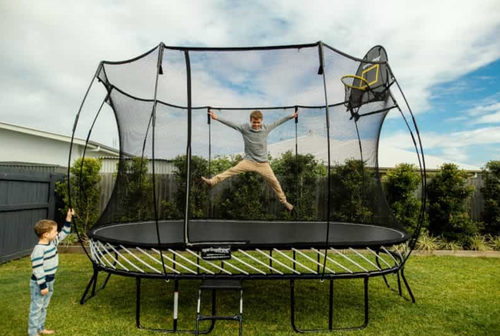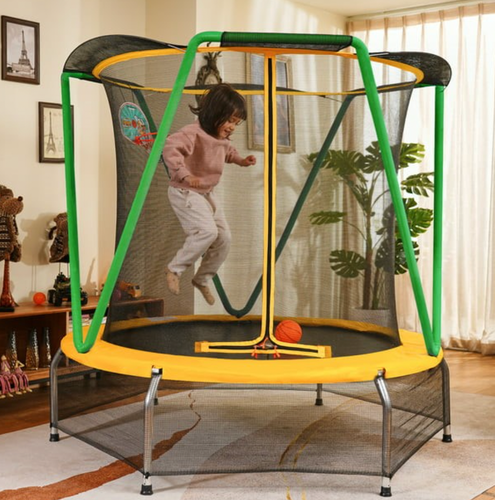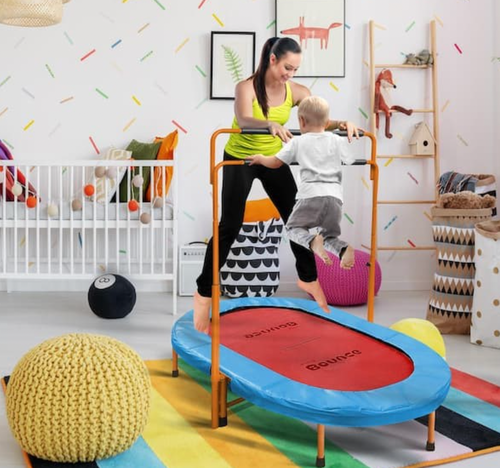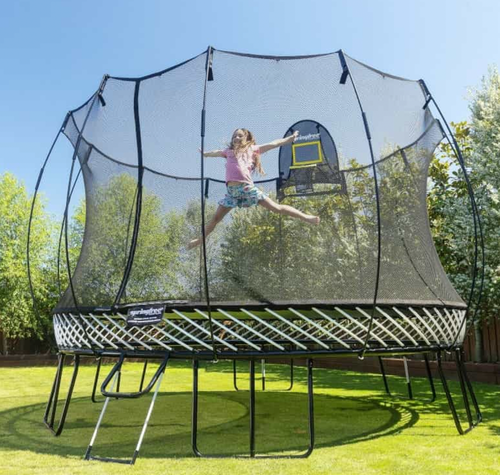In the UK, about 1 in 57 children are diagnosed with autism spectrum disorder (ASD), according to information gathered by Newcastle University.
As a parent or caregiver of a child with ASD, the goal is to find safe ways to advance your child’s skills and development.
Trampolines are a noted platform to progress the sensory, motor and educational skills of autistic children. In fact, Autism Trampoline Therapy has proven to be an informal and fun way for kids with ASD to get active while advancing their mental and physical abilities.
At Springfree Trampoline, we believe in using the joy of trampoline jumping and garden play to produce joyful moments that can last a lifetime. We also have firsthand knowledge of the power of trampolines to improve the cognitive and physical skills of not only children with ASD, but adults as well.
In this article, we will cover the benefits of trampolines for autism, assess the different types of trampolines you can buy and provide a list of the best trampolines for autism.
5 Proven Benefits of Trampolines for Autism
Let’s start by going over the specifics of how trampolines can help children with ASD:
Calming and Effective Way to Get Exercise
Trampolines are a tremendous way for autistic children to get exercise. There are numerous health benefits to trampoline jumping, including:
- Improving heart health/cardiovascular system
- Less stress on your joints
- Develops balance and coordination
- Helps with weight loss
- Improves mental health
- A form of stimming
- A way to navigate sensory processing stimuli (input and output)
- A known exercise to focus on the body’s core
In addition to the benefits listed above, trampolines can be a safe and more comfortable way for autistic children to get active.
Since social interaction can be tough for children with ASD, trampolines serve to stimulate consistent activity outdoors—which has its own set of advantages.
In a 2015 study conducted in Portugal, researchers found that “the trampoline-based training significantly contributed to the improvement of both the motor proficiency and strength of the inferior limbs” in children with ASD
Sensory System Improvement
Autistic children may struggle more than others to process sensations: Common senses include sight, smell, taste, touch and hearing.
But there are three other key sensory systems besides the five commonly known ones listed above: The vestibular, proprioceptive and interception systems.
The vestibular system, which relates to balance and head movement, and the proprioceptive system, which relates to body awareness, are particularly primed to be developed by trampoline jumping.
Jumping on a trampoline can help autistic children better process sensory information while improving their overall vestibular and proprioceptive input.

Motor Skill Development
A supporting factor to sensory improvement is developing your motor skills, which include sitting, standing, walking, running and jumping.
Trampoline jumping, in particular, helps train balance and coordination, which are much-needed skills to have as you get older.
Consistent jumping will equate to better coordination for children with ASD and contribute to the enhancement of their vestibular and proprioceptive input.
Motor proficiency was found to be significantly improved in the previously mentioned 2015 study that reviewed the impact of trampoline exercise on autistic children.
Supports Education Skills
Trampolines don’t just contribute to physical development; they can also serve as a useful platform to learn.
Autistic children sometimes have a difficult time absorbing information in traditional learning environments. Trampolines are a fun alternative to help educate children that may struggle in the classroom setting.
There are hundreds of trampoline games, many of which can be used for educational purposes. Doing basic math, spelling or calling out questions for a child to answer may be much more stimulating to an autistic child as they jump on a trampoline than if they were to sit at a desk in a classroom.
Relieves Stress and Enhances Mood
In its basic form, trampolines are designed to produce joy by jumping. Combining the exuberance of trampolines with the physical action of consistently jumping results in the release of endorphins—which are chemical signals in the brain associated with happiness.
For children with ASD who may have some difficulty in dealing with stress and anxiety, trampoline jumping can operate as a “safe space” to release some of those pent-up feelings.
A bonus to trampolines is they give you a reason to go outdoors and get some sun, which is the best natural source of Vitamin D. In addition to helping strengthen your immune system, Vitamin D is noted for its ability to increase energy levels and elevate your mood.
Watch how a Springfree Trampoline helped a child with ASD gain confidence and improved his motor skills:
Browse through Springfree Trampolines here!
Which Type of Trampoline Should You Buy?
There are plenty of benefits to trampoline jumping for ASD But the question now becomes: Which type of trampoline should you buy?
The following trampoline types are ones to consider if you’re looking for a trampoline for an autistic child:
- Toddler Trampolines – For children under six years old, a toddler trampoline would be the only option, as outdoor trampolines are not recommended for kids under the age of six.
Example of a toddler trampoline, courtesy of Walmart:

- Mini-Trampolines (Rebounders) – For autistic children that want an indoor trampoline but are past the toddler stage, a mini-trampoline, or rebounder, could be an option. These small trampolines are used primarily for exercise but encompass many of the same motor skills and sensory benefits as jumping on a big trampoline.
*NOTE: Although mini trampolines are an option, we would not recommend them for children with ASD as most do not contain a safety enclosure net. If you choose this option, be sure to supervise carefully.
Example of a mini-trampoline, courtesy of Amazon:

- Outdoor Trampolines - If you’re over six years old and have the requisite space and budget to purchase a trampoline for your garden, it could be worth it. Outdoor trampolines are accessible at any time and might be more comfortable for an autistic child to jump on since it’s located at their house.
Example of an outdoor trampoline, courtesy of Springfree Trampoline:

There are other trampoline options, with the most prominent one being the trampoline park. Although trampoline parks have their perks, they may not be the best fit for children with ASD, as they can be crowded and overstimulating.
According to Jungle Jumparoo, therapy trampolines are becoming more common and are now used in classrooms and therapy centers. So, if you don’t want to buy a trampoline but still want to try Autism Trampoline Therapy, consider looking into schools or therapy centers in your area.
What Is the Best Trampoline for Autism?
It’s evident that trampolines can provide several benefits to children with ASD, particularly in the development of their sensory, motor and physical skills.
It's not just children that can benefit from Autism Trampoline Therapy: Adults with ASD can also see immense progression in their skills, as the benefits of jumping are not limited by age!
There are many different types of trampolines to choose from and it can be tiresome to have to search online through dozens of trampolines to find the right one.
At Springfree Trampoline, we craft honest, expert-led content to educate you on everything you need to know about trampolines, so you have access to the right information to make an informed decision.
We’ve previously used our expertise to formulate lists of the best trampolines you can buy this year. Since you might be in the market for a trampoline to aid in the development of an autistic child, we have strategically chosen a few lists for you to look through that will help shorten your trampoline research process!
Check out the lists below and better your chances of getting the right trampoline the first time around:














